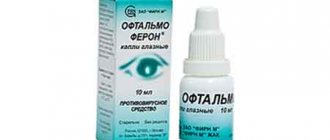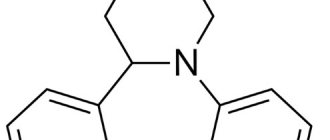Prohibited during pregnancy
Prohibited during breastfeeding
Not suitable for children
Has restrictions for older people
Has limitations for liver problems
Has limitations for kidney problems
Pyrazidol is an antidepressant that has an activating, sedative and mild nootropic effect on the human nervous system. The drug is used in psychiatry to treat depression, schizophrenia and other diseases complicated by psychomotor agitation. Pyrazidol has a number of contraindications, so, according to the instructions for use, it is strictly prohibited during pregnancy, breastfeeding, and is also not used in pediatrics.
Pharmacodynamics and pharmacokinetics
Pharmacodynamics
Summarizes the thymoleptic effect with a moderate effect on the nervous system, while the stimulating effect on patients with depression of the anergic and apathetic type is combined with a sedative effect on people in an agitated state.
Selectively, short-term and reversibly inhibits type A MAO ( monoamine oxidase ); to a large extent inhibits the deamination of norepinephrine and serotonin , and to a small extent – tyramine . The reverse addition of monoamines is also partially inhibited. Stimulates the mechanisms of synaptic transmission of excitation in nerve fibers.
Suppresses the depressive effect of reserpine , activates the effects of dioxyphenylalanine (L-dopa - a precursor of norepinephrine ), stimulates adrenergic structures and serotonergic structures, the effects of 5-hydroxytryptophan (a chemical precursor of serotonin ).
Does not have an anticholinergic effect. It has a nootropic effect and enhances cognitive functions.
Pharmacokinetics
Almost completely absorbed from the digestive tract. After a single oral dose, the highest concentration of the active component in the blood plasma is recorded after 3-7 hours. The equilibrium concentration is fixed two weeks after administration.
Removal from the blood occurs in three stages. Bioavailability is about 20-30%, almost all of the drug is metabolized in the liver. It has a high affinity for plasma proteins (up to 95%) and a long half-life - up to eight days. Distributed in the spinal cord, hypothalamus, cerebral cortex, as well as in the kidneys, liver, lungs, and spleen. About half of the metabolites are excreted by the kidneys, another 25-45% are excreted in the bile, and a small amount is excreted in the urine in its original form. Does not accumulate in the body, does not cause withdrawal or addiction syndrome.
Composition of Pyramil tablets
The medicine is produced by companies from Poland and Switzerland. Available in tablet form.
Table 1. Composition of Pyramil.
| Active substance | |
| Ramipril | It has a pronounced antihypertensive effect, has a vasodilating effect, and acts as a cardioprotector. |
| Excipients | |
| Microcrystalline cellulose | Widely used in the production of medicines as a thickener. Has an absorbent effect. Promotes rapid absorption of the active substance Pyramil. |
| Gelatinized starch | This is corn starch that has undergone special processing. They help to increase the hygroscopicity of a substance (it absorbs a large amount of moisture) and increase its adhesive ability. Used as a thickener. |
| Precipitated silica | It has absorbent properties, promotes rapid absorption of the active substance, and is a catalyst. |
| Glycine hydrochloride | Reduces psycho-emotional stress, increases the body's performance, and is a metabolism regulator. |
| Glyceryl dibehenate | Has a softening and unifying effect. Used to obtain the required consistency of Pyramil tablets. |
Instructions for use of Pyrazidol (Method and dosage)
Instructions for use of Pyrazidol prescribe taking the drug orally.
Pyrazidol is prescribed at an initial dose of 50-75 mg per day in 2 divided doses. It is gradually increased by 25-50 mg until a dose of 150-300 mg per day is reached. The maximum daily dose is 400 mg. Usually the dose is divided into 2-3 doses.
After fixing the therapeutic effect, the drug is continued to be taken in an individually selected dosage for up to one month. Then the dose is slowly reduced.
Contraindications to the use of the drug
Pyrazidol is a drug with low toxicity. In this regard, the product has a minimum of contraindications for use. However, existing contraindications to taking Pyrazidol should not be ignored under any circumstances! Contraindications in this case are:
Loading…
- individual intolerance to the drug, which is usually manifested by allergic-type reactions - skin rash, increased fever, urticaria, edema syndrome, possible development of a state of shock;
- inflammatory liver diseases in the acute phase;
- pathologies of the hematopoietic system;
- period of treatment with drugs related to non-selective monoamine oxidase inhibitors.
Drug and pregnancy
Regarding the use of Pyrazidol during pregnancy and breastfeeding, it should be noted that the official instructions do not contain any data regarding this. This does not mean that the medicine is unconditionally approved for use in pregnant and lactating women.
The features of the drug are as follows:
the effectiveness of the drug can only be assessed four weeks after the start of treatment; after long-term treatment with Pyrazidol, its cancellation is possible with a gradual reduction in dosage over the course of a month; the medicine is used not only for the treatment of depression in patients undergoing inpatient treatment, but also in outpatient patients with minor depressive disorders; the drug is capable of simultaneously having an activating and sedative effect without the effect of drowsiness, hypersedation, or lethargy; Pyrazidol has a dose-dependent effect - in small dosages it has an activating effect, with increasing doses the anti-anxiety effect is clearly manifested; unlike other antidepressants, Pyrazidol is very effective for depressive syndromes of a vague nature; an important feature of the drug is the absence of cardiotoxicity - Pyrazidol does not change blood pressure levels and does not affect the heart rate; Research is currently being conducted on the use of the drug for depressive disorders in old age;
the drug compares favorably with other antidepressants in that it does not cause unwanted reactions from the reproductive system; Pyrazidol is widely used in neurological practice for depressive disorders associated with Parkinson's disease, mild dementia of vascular and atrophic origin.
The above features of Pyrazidol indicate its advantages relative to other drugs that have antidepressant effects.
Interaction of the drug with other drugs
When prescribing Pyrazidol, the doctor will definitely ask the patient about medications taken constantly or periodically for the treatment of other diseases. For example, the doctor will not prescribe Pyrazidol if the patient is taking other medications related to monoamine oxidase inhibitors, as well as Selegiline, Furazolidone, Procarbazine. The use of the drug together with adrenergic agonists enhances the pressor effect. With simultaneous use of the drug with thyroid hormones, the development of arterial hypertension is possible. In case of interaction with Cimetidine, the metabolism of Pyrazidol may slow down and the risk of adverse reactions may increase. The effect of drugs with analgesic properties is enhanced when taken together with Pyrazidol.
Pyrazidol is capable of interacting with many drugs of various pharmacological groups. That is why Pyrazidol is not used independently, but is prescribed only by a specialist!
Adverse reactions
If the dosage of the medication is exceeded for a long time, undesirable effects such as hand tremors, dry mouth, increased sweating, dizziness, and sometimes nausea and vomiting may occur. In cases of individual intolerance, signs of an allergic reaction may appear, which is expressed in the appearance of a rash and increased body temperature. Urticaria-type rashes and the development of laryngeal edema, which requires urgent medical intervention, are also possible.
Interaction
When co-prescribed or used with Pyrazidol immediately after or during treatment with drugs that block MAO (for example, procarbazine, moclobemide, selegiline, furazolidone ), severe complications such as serotonin syndrome .
Pyrazidol can increase the sensitivity of patients to epinephrine and a number of other amine sympathomimetics - this should be taken into account if their combined use is necessary.
Synonyms of nosological groups
| Category ICD-10 | Synonyms of diseases according to ICD-10 |
| F10.3 Withdrawal state | Alcohol withdrawal syndrome |
| Withdrawal syndrome | |
| Withdrawal syndrome in alcoholism | |
| Abstinence | |
| Alcohol withdrawal | |
| Alcohol withdrawal | |
| Alcohol withdrawal state | |
| Alcohol withdrawal syndrome | |
| Post-withdrawal disorder | |
| Post-withdrawal state | |
| Hangover syndrome | |
| Withdrawal syndrome | |
| Alcohol withdrawal syndrome | |
| Alcohol withdrawal syndrome | |
| Withdrawal state | |
| F32 Depressive episode | Adynamic subdepression |
| Astheno-adynamic subdepressive states | |
| Astheno-depressive disorder | |
| Astheno-depressive state | |
| Asthenodepressive disorder | |
| Asthenodepressive state | |
| Major depressive disorder | |
| Sluggish depression with lethargy | |
| Double depression | |
| Depressive pseudodementia | |
| Depressive illness | |
| Depressive mood disorder | |
| Depressive disorder | |
| Depressive mood disorder | |
| Depressive state | |
| Depressive disorders | |
| Depressive syndrome | |
| Depressive syndrome larvated | |
| Depressive syndrome in psychosis | |
| Masked depressions | |
| Depression | |
| Depression of exhaustion | |
| Depression with symptoms of lethargy within the framework of cyclothymia | |
| Depression smiling | |
| Involutional depression | |
| Involutionary melancholy | |
| Involutional depressions | |
| Manic-depressive disorder | |
| Masked depression | |
| Melancholic attack | |
| Neurotic depression | |
| Neurotic depression | |
| Shallow depressions | |
| Organic depression | |
| Organic depressive syndrome | |
| Simple depression | |
| Simple melancholic syndrome | |
| Psychogenic depression | |
| Reactive depression | |
| Reactive depression with moderate psychopathological symptoms | |
| Reactive depressive states | |
| Reactive depression | |
| Recurrent depression | |
| Seasonal depressive syndrome | |
| Senestopathic depression | |
| Senile depression | |
| Senile depression | |
| Symptomatic depression | |
| Somatogenic depression | |
| Cyclothymic depression | |
| Exogenous depression | |
| Endogenous depression | |
| Endogenous depressive states | |
| Endogenous depression | |
| Endogenous depressive syndrome | |
| G30 Alzheimer's disease | Alzheimer's disease |
In short:
Antidepressants and alcohol should almost never be combined.
Only if you take antidepressants based on ademetionine or St. John's wort can you take alcohol in hangover-free doses. The vast majority of antidepressants are categorically incompatible with alcohol. The presence of alcohol in the blood sharply increases the likelihood of side effects of antidepressants: they can cause many serious complications on various body systems, primarily on the central nervous system. Therefore, it is prohibited to combine alcohol with almost all antidepressants.
In addition, antidepressants are often hepatotoxic, meaning they can negatively affect the liver even on their own. If you also drink alcohol, the likelihood of liver damage increases sharply. Read about how to avoid liver damage from medications and what to do if damage has already occurred.
It is allowed to drink alcohol once a week in hangover-free doses (1 glass of vodka or cognac) only if you are taking antidepressants containing the following main active ingredients (the most popular trade names of drugs containing this active ingredient are indicated in brackets):
- ademetionine (heptor, heptral)
- St. John's wort (negrustin, deprim, life 600)
Try not to get carried away and not exceed the specified dose of alcohol, do not forget to then take a break from alcohol for at least a week. And don't take even small amounts of alcohol with any other antidepressants.
You can combine alcohol with these antidepressants in hangover-free doses, but not more than once a week.
Analogs
Level 4 ATC code matches:
Pipofezin
Bethol
Incazan
Melitor
Azafen
Miaser
Velafax
Mirtazonal
Venlaxor
Remeron
Venlafaxine
Lerivon
Mirtazapine
Cymbalta
Velaxin
Coaxil
Deprim
Gelarium Hypericum
Negrustin
Trittico
Cymbalta, Alventa, Velaxin, Wellbutrin SR, Venlaxor, Venlift, Gelarium Hypericum, Melitor, Deprivit, Mirzatel, Mirtel, Trittico and others.
Side effects
Negative side effects when taking this drug may include the following:
- indigestion;
- dry mouth;
- nausea;
- dizziness;
- tremor of the whole body.
In rare cases, tachycardia, increased sweating and allergic skin reactions may occur.
Pyrazidol price, where to buy
The price of Pyrazidol 25 mg No. 50 is 139-159 rubles, and the price of a package of drug No. 50 with a dosage of 50 mg is 220-249 rubles.
- Online pharmacies in RussiaRussia
ZdravCity
- Pyrazidol tablets 25 mg 50 pcs. JSC Pharmstandard (ICN) Leksredstva Kursk
143 rub. order
In what cases is it recommended to use the medicine?
The medication is considered one of the popular means for combating depressive conditions that arise as a result of various reasons. The following mental pathologies are indicated for the prescription of Pyrazidol:
- Lethargy, asthenia, anxiety, delusional ideas. The medicine is recommended in cases where these manifestations are accompanied by depression.
- Hangover syndrome in patients suffering from chronic alcoholism.
- Senile dementia (in this situation, the drug is used as one of the methods of complex therapy).
- Depressive conditions in the elderly.
The medication has almost no contraindications. However, there are categories of patients who should not use Pyrazidol. The instructions indicate conditions that are reasons for prohibiting its use.
Pharmacological authorities
Pharmacodynamics. Antidepressant with a cyclic structure. Similar to indole, water has elements of structural similarity to serotonin, reserpine and other condensed indolic compounds. Vibrantly, for a short time, it reversely suppresses monoamine oxidase type A, significantly blocks the desalination of serotonin and norepinephrine, and, in a lesser world, thiamine.
Partially blocks the portal storage of serotonin and other monoamines, stimulates adrenergic structures, activates the processes of synaptic transmission of nerve stimulation in the central nervous system. Reduces the depressive effects of reserpine, enhances the effects of levodopa, phenamine, serotonin precursor - 5-hydroxy-tryptophan, stimulates serotonergic structures.
The particularity of the action is the combination of a thymoleptic effect with a regulating influx on the central nervous system, which is similar to the active influx in patients with apathetic and anergic depression and sedative effect in patients From agitation camps. It exhibits a nootropic effect, improves cognitive functions, and does not have anticholinergic activity.
Pharmacokinetics. It is practically completely absorbed from the scolio-intestinal tract. After a single dose, the maximum concentration of active substance in blood plasma is reached after 2-8 years. The same concentration in blood plasma is reached 2 days after ingestion.
Elimination from blood plasma occurs in three phases. Absolute bioavailability is 20–30%, and is mostly metabolized in the liver. There is a high level of binding to plasma proteins (90-95%) and, as a result, a long period of ingestion - approximately 185 years. It is distributed in the cerebral cortex, hypothalamus, spinal cord, as well as in the leg, liver, neck, and spleen.
tablets, cream color, thick, scored.
Adverse reactions
Pirasidol is extremely well tolerated. Adverse reactions are mild and usually occur with a reduced dose of the drug. Rarely, dry mouth, hand tremors, tachycardia, excessive sweating, confusion, fatigue, and allergic reactions may occur.
With one-hour stagnation or administration of pyrazidol after therapy with drugs that suppress monoamine oxidase (including selegiline, moclobemide, procarbazine, furazolidone), there may be a development of important complications (seroton new syndrome).
Parasidol increases the sensitivity of patients to epinephrine and other sympathomimetic amines, which follows the evidence of an acute need for their extreme constipation.
Parasidol has a nootropic effect and improves cognitive functions in patients. Prote, any psychotropic drug can reduce the mental process and manual skills, patients should be warned in advance about the need to exercise caution when working with potentially unsafe mechanisms and when using a car. mobile
Please come in with special care
The drug should not be administered immediately or for 14 days after treatment with monoamine oxidase inhibitors. As with therapy with other antidepressants, if these recommendations are not carefully followed, the development of serious, sometimes fatal, reactions (serotonin syndrome) is possible.
It is necessary to consider the possibility of increased sensitivity to epinephrine and other sympathomimetic amines whenever they are administered to the patient during the treatment with pearlindole. For acute reasons, the use of these drugs during treatment is not recommended. During the holiday you cannot drink alcohol.
Showing
Depressions of various origins, especially with psychomotor hypersensitivity, anxiety-depressive and anxiety-like components, hypochondriacal and neurosis-like symptoms. Manic-depressive psychosis, schizophrenia with affective disorders and involutional psychosis, which occurs with a pronounced depressive component. Anxiety and depression during the period of alcohol or nicotine withdrawal.
Increased individual sensitivity to pearlindole or other components of the drug; stagnation of monoamine oxidase inhibitors overnight and/or before 14 days; acute hepatitis, disease of the blood system; Vagity, lactation period; childhood until the 18th century.











![Grippostad with instructions for use [2]](https://karipazim-farm.ru/wp-content/uploads/grippostad-s-instrukciya-po-primeneniyu-2-330x140.jpg)